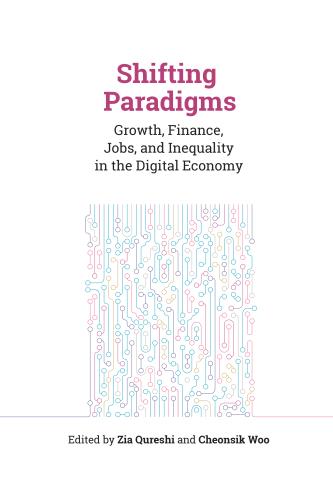This is the first in a series of blogs sharing insights from the new book “Shifting Paradigms: Growth, Finance, Jobs, and Inequality in the Digital Economy.”
We are living in a time of exciting technological innovations. Digital technologies are driving transformative change. Economic paradigms are shifting. The new technologies are reshaping product and factor markets and profoundly altering business and work. The latest advances in artificial intelligence and related innovations are expanding the frontiers of the digital revolution. Digital transformation is accelerating in the wake of the COVID-19 pandemic. The future is arriving faster than expected.
A recently published book, “Shifting Paradigms: Growth, Finance, Jobs, and Inequality in the Digital Economy,” examines the implications of the unfolding digital metamorphosis for economies and public policy agendas.
Digital transformation: Promise and pitfalls
The new technologies hold great promise. They create new avenues and opportunities for a more prosperous future. But they also pose new challenges. While digital technologies have dazzled with the brilliance and prowess of their applications, they have so far not fully delivered the expected dividend in higher productivity growth. Indeed, aggregate productivity growth has slowed in the past couple of decades in many economies. Consequently, economic growth has trended lower.
To realize the promise of today’s smart machines, policies need to be smarter too.
At the same time, income inequality and related disparities have increased, particularly in advanced economies, stoking social discontent and political ferment. Across economies, there is uneven participation in the new opportunities created by digital transformation. Many are being left behind, across industries and firms, the workforce, and different segments of society.
Firms at the technological frontier have broken away from the rest, acquiring dominance in increasingly concentrated markets and capturing the lion’s share of the returns from the new technologies. While productivity growth in these firms has been strong, it has stagnated or slowed in other firms, depressing aggregate productivity growth. Increasing automation of low- to middle-skill tasks has shifted labor demand toward higher-level skills, hurting wages and jobs at the lower end of the skill spectrum. With the new technologies favoring capital, winner-take-all business outcomes, and higher-level skills, the distribution of both capital and labor income has tended to become more unequal, and income has been shifting from labor to capital.
One important reason for these outcomes is that policies and institutions have been slow to adjust to the unfolding transformations. To realize the promise of today’s smart machines, policies need to be smarter too. They must be more responsive to change to fully capture potential gains in productivity and economic growth and address rising inequality as technological disruptions create winners and losers.
As technology reshapes markets and alters growth and distributional dynamics, policies must ensure that markets remain inclusive and support wide access to the new opportunities for firms and workers. The digital economy must be broadened to disseminate new technologies and opportunities to smaller firms and wider segments of the labor force.
Firms, workers, and policymakers face many questions. While digital technologies offer large productivity payoffs, they create new challenges for firms as production processes, sources of competitive advantage, and market structures shift. Is rising industrial concentration, as reflected in the increasing market dominance of tech giants, inevitable with these technologies or can their benefits be shared more widely across firms to lift aggregate productivity and foster more robust economic growth? Regarding the rapid change seen in financial markets, how can the promise of digital innovations in finance be captured while managing risks? Should workers fear the new automation as the nature of work and skill needs change and many old jobs and tasks disappear? How should they adapt? In what ways are technology-driven shifts in business and work causing economic disparities to widen? How should public policy respond?
Revamping policies for the digital era
“Shifting Paradigms” addresses these questions by showing that policies matter. New thinking and adaptations are needed to realign policies and institutions with the digital economy. Areas for attention include competition policy and regulatory regimes, the innovation ecosystem, digital infrastructure, workforce development, social protection frameworks, and tax policies.
Competition policy should be revamped for the digital age. Antitrust laws and their enforcement must be strengthened. The digital economy poses new regulatory challenges that must be addressed, including issues surrounding the regulation of data (the lifeblood of the digital economy), competition issues relating to digital platforms that have emerged as gatekeepers in the digital world, and market concentration resulting from tech giants that resemble natural or quasi-natural monopolies because of economies of scale and network effects associated with digital technologies. As in product markets, policymakers need to ensure that financial markets remain sufficiently competitive and address regulatory challenges relating to the new world of digital financial products, platforms, and algorithms. Also, new frameworks are needed for international collaboration in areas such as regulation of cross-border data flows and taxation of cross-border digital business.
The innovation ecosystem should be improved. Aging patent systems should be updated to the new innovation dynamics of the digital economy, better balancing incumbent interests and wider technology promotion and dissemination. Public research and development programs should be revitalized to foster technological progress that serves broader economic and social goals rather than the interests of narrow groups of investors. Policymakers must correct biases in tax systems favoring capital relative to labor that create incentives toward “excessive automation”—which destroys jobs without enhancing productivity.
The foundation of digital infrastructure must be strengthened to broaden access to new opportunities. This calls for increased public investment and frameworks to encourage more private investment to improve digital access for underserved groups and areas. The digital divide remains particularly wide in developing economies. Stronger digital infrastructure and literacy will be crucial for these economies as technological change forces a shift away from growth models reliant on low-skill, low-wage manufacturing.
Investment in education and training programs should be boosted and reoriented to emphasize skills that complement the new technologies. This will require innovation in the content, delivery, and financing of these programs, including new models of public-private partnerships. With the fast-changing demand for skills and the growing need for upskilling, reskilling, and lifelong learning, the availability and quality of continuing education should be greatly scaled up. The potential of technology-enabled solutions such as online learning tools must be harnessed. Persistent inequalities in access to education and (re)training must be addressed. While gaps in basic capabilities across income groups have narrowed, those in higher-level capabilities that will drive success in the digital economy are widening.
Labor market policies and social protection systems should be realigned with the changing economy and the nature of work. Policies need to shift to a more forward-looking focus on improving workers’ ability to move to new and better jobs rather than seeking to protect existing jobs being rendered obsolete by technology. Unemployment insurance schemes should better support workers in adjusting to change, retraining, and transitioning to new jobs. Worker benefits systems, covering benefits such as pensions and health care, which traditionally have been based on formal long-term employer-employee relationships, will need to adjust to a job market with more frequent job transitions and more diverse work arrangements (including an expanding gig economy). Institutions that give adequate voice to workers are important too as technology shifts the balance of market power. How social contracts provide opportunity, risk sharing, and security needs to be rethought for the digital age.
Enabling broader participation of firms in the innovation economy, widening the diffusion of new technologies, and building complementary capabilities in the workforce can deliver both stronger and more inclusive economic growth. Reforms in these areas can reduce inequality and economic insecurity more effectively than fiscal redistribution alone. In capturing the full promise of digital transformation, the growth and inclusion agendas are one and the same.







Commentary
How digital transformation is driving economic change
January 18, 2022